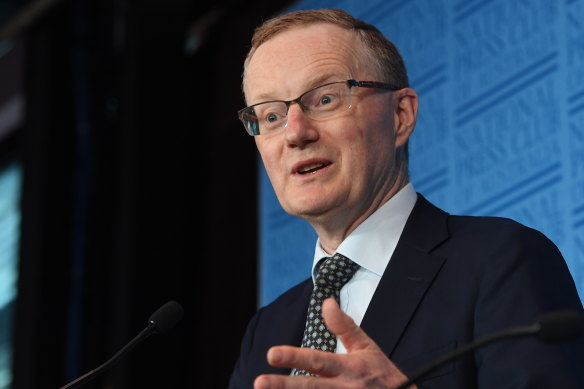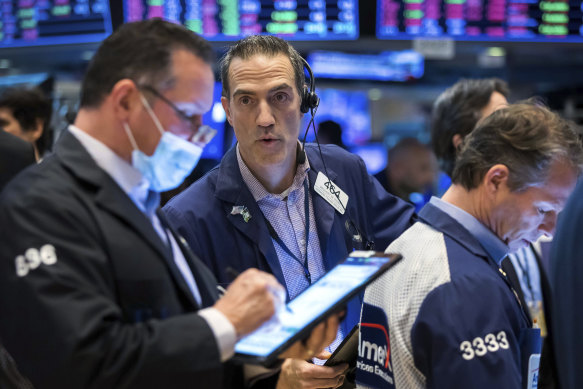There has been some softening in the language of other Fed officials in recent weeks, which has triggered something of a turnaround in financial markets.
The US sharemarket is up nearly 9 per cent in the past fortnight, despite a savage sell-off of the mega technology stocks, and yields on US government bonds and notes have fallen back in the past 10 days.
The yield on the US benchmark 10-year bond was 4.24 per cent on October 24. It’s now 4.01 per cent. Yields on the two-year notes have fallen from 4.61 per cent on October 20 to 4.4 per cent. That suggests investors expect, if not a pivot from the Fed, then some tapering of the rate of US interest rate rises at future meetings.

RBA governor Philip Lowe is set announce another rate rise.Credit:Peter Braig
The RBA’s decision to move the 50 basis point increases that were announced each month from last June to 25 basis points at its October 5 meeting is being cited in support of the view that the Fed is risking overkill if it continues to add jumbo rate hikes. Last week the Bank of Canada raised its policy rate by a smaller-than-expected 50 basis points. It had previously raised rates, four times, in 75 basis point increments.
The positions of the BoE, with the UK inflation rate heading into double-digits, and the European Central Bank, which announced a 75 basis point rise in eurozone rates last week and has now raised its rates by 200 basis points in three months, are somewhat different to the Fed’s or RBA’s.
The war in Ukraine has had larger and more direct and probably lasting impacts on Europe and the UK, most notably via the acute energy crisis, than on the US or Australia.
The challenge for central banks is that monetary policies operate with a lag.
Markets are forward-looking – they price in conditions somewhere between 12 and 18 months ahead – so, if the bounce back in markets could be sustained, it would say investors can see interest rates peaking and subsequently declining sometime next year.
The Fed and the RBA know that the current inflation rate remains stubbornly high – the core inflation rate that it watches most closely (the rate excludes volatile food and energy prices) is more or less steady but at an historically high level.
Powell and RBA governor Philip Lowe don’t know, however, whether what they have done so far – and will almost certainly do this week – will be enough to throttle economic activity next year and lower their inflation rates in the process.
The Fed also doesn’t know whether the rapidity with which it has tightened US monetary policy might trigger leverage or illiquidity-driven financial crises in its system, and/or elsewhere in the world.
Loading
There’s also the unknown of how much inflation is still being driven by the effects and after-effects of the pandemic and the government and central bank responses to it and therefore how much of those influences might, or might not, work their way out of the system over time.
Commentary about their outlook, with disclosures of weakening sales and build-ups of inventories, sank the share prices of the big tech companies – Meta (Facebook’s parent), Amazon, Alphabet (Google’s parent) and Microsoft among them – last week. Their comments suggested consumers are now responding to inflation and the economic uncertainty and stress it has generated.
The “FAANG” index of the biggest tech companies (Facebook, Amazon, Apple, Netflix, Google and other large tech companies) has fallen about nine per cent in a month, most of it last week.
Overall, however, the US sharemarket has risen in the past fortnight or so, by about 9 per cent. Markets are forward-looking – they price in conditions somewhere between 12 and 18 months ahead – so, if the bounce back in markets could be sustained, it would say investors can see interest rates peaking and subsequently declining sometime next year.

Even in the face a tech slump, the US sharemarket has risen by about 9 per cent. in the past fortnight or so. Credit:NYSE
At the moment, the US bond market is pricing in a 75 basis point increase this week, 50 basis points in December and then a move to the more traditional 25 basis point increments in the first half of next year, with a “terminal” rate – the peak of this cycle – of 4.75 per cent to 5 per cent next year.
The dilemma both the Fed and RBA have is that unemployment rates are at historically low levels and are producing labour shortages that will result in wage increases. Historically, surging inflation rates are only crushed by steep increases in unemployment levels.
Even without a steep rise in unemployment, the sharply increased borrowing costs for consumers — particularly for housing and businesses might –might create sufficient financial stress that they dampen activity and start to eat away at inflation rates and inflation expectations.
While soft landing from periods of monetary policy tightening are almost impossible to achieve – the central banks almost always tighten too hard – there have been a number of “softish” landings after periods of monetary policy tightening in the past.
Loading
For the central banks, given that data is historical, achieving the delicate balance of bringing inflation under control without wrecking their economies will be as much about intuition as the dismal science. This week will provide some insights into whether they’ve reached the point where they can even contemplate trying to engineer that outcome.
The Market Recap newsletter is a wrap of the day’s trading. Get it each weekday afternoon.
Stay connected with us on social media platform for instant update click here to join our Twitter, & Facebook
We are now on Telegram. Click here to join our channel (@TechiUpdate) and stay updated with the latest Technology headlines.
For all the latest Business News Click Here
For the latest news and updates, follow us on Google News.
